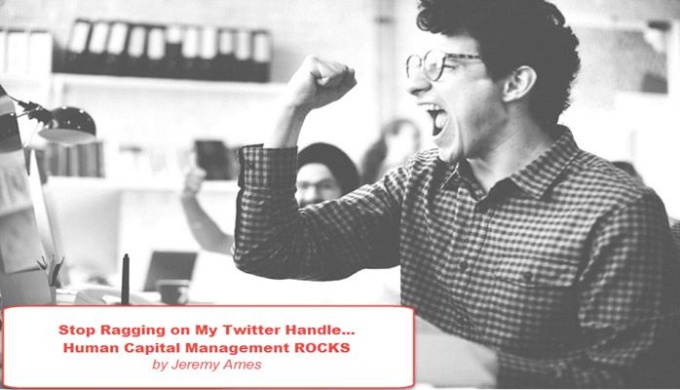Click here to view original web post at www.linkedin.com
The reasons I get asked why I chose the Twitter handle @TheHCMGuy tend to fall into 3 buckets:
- The asker thinks the handle is slightly arrogant, as if anointing oneself as “the guy” of anything is pretty presumptuous. Fair point well made…but bear in mind @TheHCMDummy was already taken.
- While I was going about the switch from @JeremyAllynAmes to @TheHCMGuy, the trend has been to use your actual name as your Twitter handle instead of a vanity handle. Yeah, I’m not much into following trends.
- The asker wonders why I chose HCM over other more commonly used terms like HR, or more progressive terms like People Management? Hmm, let’s explore that one a bit by breaking out the components of HCM.
Human
Until artificial intelligence constitutes a larger percentage of the workforce than us, I have to have me some “human” in my professional acronym. I even wrote about how, in the context of HR software companies, humans are often more important than the software itself. Granted, there are plenty of instances, such as manufacturing companies, where one could easily argue that the equipment, components and mechanical processes are actually more critical to the success of the business. However, there are already departments that manage those functions, and the skill sets required to do so don’t always translate to the proper management of humans. Besides, anyway you slice and dice your end product, you’re still going to need humans to facilitate the right decisions that make it all possible.
As for the use of “people” versus “human,” while I do like the ring of People Management, the connotation of the word “human” reminds us that we need to treat and be treated as such. Simply consider how well the following sentences resonate side-by-side.
- People need to have the proper work/life balance in order to be truly happy in their profession.
- Humans need to have proper work/life balance in order to be truly happy in their profession.
Besides, wouldn’t you rather treat a fellow team member humanely than peoply?
Capital
“Capital” can’t help but be subjected to comparison to Resources, the more commonly used word whose overall term even found its way into my Hive Tech HR company name. (For the record, that makes me unwilling to rebrand again, not hypocritical). While you may have your own inclination on which fits better, to remove the subjectivity let’s simply look at straight out definitions of the two.
- Capital: “relating to or being assets that add to the long-term net worth of a corporation.”
- Resources: “a supply of something (such as money) that someone has and can use when it is needed”
There you have it. It boils down to the gut reaction you may have always had to the word resources, which is that it sounds too heavily weighted towards the company. “Can be used when needed” could often be followed by and tossed to the curb when that’s no longer the case.
Now, as for capital, when you treat someone like an “asset” (and you’re careful to maintain the -et), he or she will feel much more inclined to try to add “long term net worth” to the company.
Management
What I’ll open with here is that by dropping off the term “management,” as in the case of Human Resources, all we’ve really done is define what group we’re servicing, but not actually what action we’re supposed to take with them.
That in actuality is kind of a symbolic part of HR criticism and identity crises whereby the function can either be boiled down to tracking these human resources administratively, or basically leaving it up to those in charge to decide whether they need to actively take part in their success.
Luckily most companies have recognized, emphatically, that HR needs to be doing more with the organization’s humans than just tracking them as the move like cattle through the employee lifecycle.
That’s where management comes in, and what’s great about it the term is that it can mean so many different things. The HCM function can manage humans by facilitating/monitoring the traditional concept of management, as in supervisors, mentors, etc. They can help manage their interactions by facilitating the proper communication channels. They can manage how they find the company, assimilate into the company, enjoy the company while here, and successfully exit the company when the time comes. And lastly, they can do much of this by adding on a layer of technology to make the management easier and more effective. It can even be extended to management of humans by the digitalization of the workplace. That, overall, is why the term management fits best; you can’t effectively manage without technology and technology is meaningless without adequate management.
In Closing
One last thing I’ll leave you with is that we’re not solely defined by our work. Even though I mostly use Twitter as a professional channel, I occasionally lapse into the personal. While HCM is traditionally used in the professional context, when you think about it, whether or not we’re managing employees or our family and friends, a good portion of our lives is spent managing the human capital that surrounds us. Humans want to be treated as assets whether it’s in the office, the baseball field, the home, or anywhere for that matter.
============================================================
ABOUT ME
I enjoy being @TheHCMGuy and even being questioned about why I use the handle…bring it on. I’m CEO of Hive Tech HR, which helps our clients create HCM strategies and find/implement HR technology. I’m proud to say that, as a former board member of IHRIM and SHRM’s HR Management and Technology Expertise Panel, I still stay involved with both associations and invite you to join me in the following events:
- If you read this today, July 27th, 2016, join me at 3PM EST on SHRM’s “Tweetchat” called #Nextchat. People around the world will be talking about improving the employee experience with HR Technology, and I’ll be the guest host. The link is here: http://blog.shrm.org/blog/nextchat-improving-the-employee-experience-with-hr-tech. (Actually I used the image from the chat advertisement on this post).
- Or join me September 7th for an IHRIM webinar on navigating the HR Tech landscape.
And follow me @TheHCMGuy (duh, of course)
And/or Hive Tech @HiveTechHR
And, if you’re so inclined, call us at 844-Hive-Tec (448-3832) for that next big HCM project.

